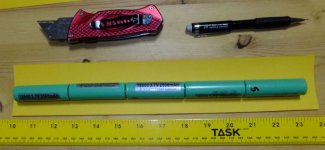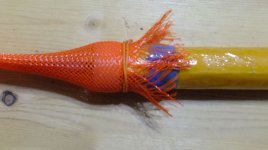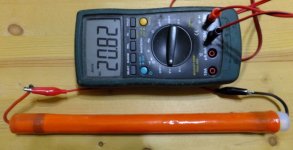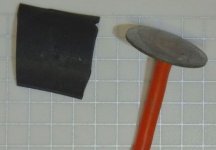I have the first prototype finished.

I began by using a utility knife and a steel straightedge to cut a piece of paper exactly 60mm wide and about 14 inches long.

Next the paper was rolled around a string of batteries and the long 'edges' joined using masking tape. The paper tube was then trimmed to a length of 12.5 inches.
A 'Penny Tube' was cut in half. The terminals were slipped into the ends of the penny tube halves.
The pieces were then slipped over the ends of the paper tube (filled with cells) and secured in place with masking tape.

Two more layers of paper were added to fill in the gap between the pieces of the penny tube. These were simply glued to underlying layer using carpenter's wood glue.
The wood glue had the undesired effect of softening the paper. I applied two coats of two-part polyester resin to the outside diameter of the tube.
My perception was the tube finished in this manner was still a bit on the weak side. The tube is easily bent. This can create a crease in the tube making the cells difficult to slide in and out.

I decided to add an addition layer to strengthen the tube. My first thought was to use Braided Woven Carbon Fiber Sleeving but that stuff is relatively expensive.
As an alternative I decide to try 3/4" PET Expandable Braided Sleeving: https://www.amazon.com/gp/product/B00V3PTEXU
I tied the the sleeving to the capped end of the tube with wire.

A coating of ployester resin was applied to the outside of the tube and the sleeving then pulled over the tube.
Two more coats of resin were applied to the outside of the sleeving. After the resin cured the rough end was trimmed and sanded.

Battery Configuration: 5S x 1P
Nominal Voltage: 18 Volts
Finished weight: 293 grams
(capped tube with terminals and wires = 66 grams)
Finished Length: 340 mm
Largest Finished Outside Diameter: 27 mm
Smallest Finished Outside Diameter: 23 mm
Lessons Learned:
1) The concept is valid and this method should be able to be used to produce a battery of any desired configuration.
2) My skills with two part resin are nothing short of abominable. Hopefully those will improve with some more experience.
3) The material selection needs to be refined.
..a) The paper I used was too soft. I am thinking either 100% rag vellum or perhaps even common 20 pound bond would be better.
..b) The Penny tubes work but are a bit fragile. Purpose 3D printed end cap might be ideal.
..c) The magnets and silicon gaskets worked as expected. It might be just as effective to use the paper ring gaskets available for 18650 welded packs.
..d) The PET Braided Sleeving was inexpensive and provided sufficient reinforcement.
4) Both ends of the tube should have removable caps to aid in removing the cell string.
5) Using a string of cells for the 'form' works but a precisely sized rod would be a valuable asset in construction of the tube.
6) Folding the Braided Sleeving over the wire resulted in a large bulge at the top of the tube. It would be better to cover the threads with something like wax paper and extend the sleeving beyond the end of tube. The excess sleeving could then be trimmed from the tube with a sharp utility knife after the resin had set.
Additions Thoughts:
1) Using 6mm copper binding posts for the terminals would eliminated the need of soldering and provide flexibility to arrange the tubes in various configurations.
2) A seperate thin paper tube that slides in and out with the cells might be desirable.









